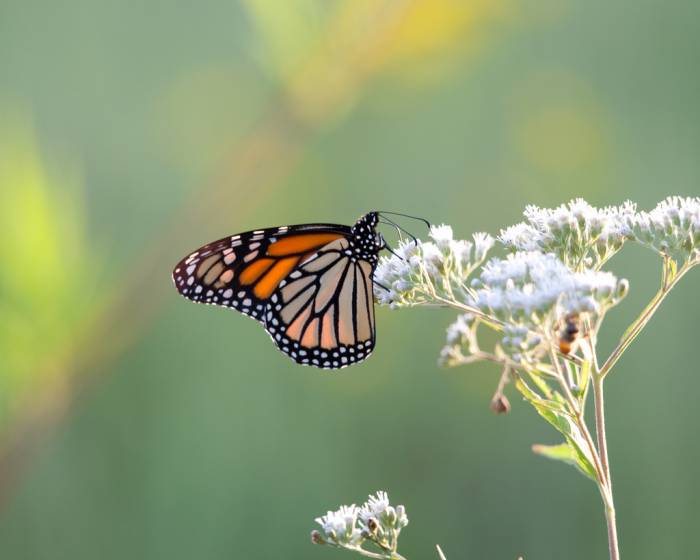[leadin]For more than a decade, milkweed, that tall green plant with purple or orange flowers, has been rapidly declining in Midwestern states.[/leadin]

Little research has been done on the abundance of milkweed in Western states, though many scientists suspect it may be struggling as well. That’s because Western monarch butterflies, which depend on milkweed for food and habitat, have declined by nearly 90 percent in the past two decades. Both of these troubling trends — the decline of milkweed in the Midwest and of monarch butterflies — have coincided with a rise in agricultural use of the herbicide glyphosate.
While the impact glyphosate has on milkweed and monarchs is well-known, the damage it does to other plants and animals is largely a mystery. Now, the EPA has announced it will spend the next five years studying the effects of glyphosate (more commonly referred to by its trade name, Roundup), atrazine, and two other commonly used pesticides on 1,500 endangered species.
The study is the result of a settlement between the EPA and the Center for Biological Diversity after it sued the agency in 2007 for violating the Endangered Species Act. The ESA requires consultation for any federal action likely to jeopardize the habitat and survival of a listed species. The center claimed the EPA didn’t do its due diligence to figure out how such pesticides would affect rare species in the San Francisco Bay Area before registering the chemicals. In 2010, the court ruled that the EPA would have to examine the chemicals’ effects on 11 species in the region. Last month’s amendment forces the agency to take that study to a national level.
Although Roundup has been around since the 1970s, its effects haven’t been broadly studied since 1993, when only 10 million pounds were used annually. Today, more than 300 million pounds are applied to U.S. fields each year.
This is the crux of the problem. Unlike atrazine, which is less prevalent but so toxic it can lead to sex changes in some amphibians, glyphosate has a volume problem, says Brett Hartl, endangered species policy director for the Center for Biological Diversity. The sheer prevalence of Roundup makes its plant-killing effects felt on a massive scale. In the end, he hopes the assessment will lead to a national ban on atrazine, and limitations on glyphosate application.
While the expansion of the original EPA study has been a step forward for conservation groups, it may not be a sign of things to come. “If there’s a trend, we’re still in the very early stages of it,” Hartl says. “We’ve been pushing the EPA very hard to consider endangered species, and they’re starting to.”
Last year, the Center for Biological Diversity also reached a settlement with the U.S. Fish & Wildlife Service that required the agency to study the impacts of five insecticides on endangered species. However, around the same time, the EPA rejected a petition from the Natural Resources Defense Council asking for a review of glyphosate’s impact on monarchs and the implementation of measures to reduce harm to the species.
“The primary concern for the monarch butterfly and its resources should not be focused on glyphosate,” Jack Housenger, the EPA’s office of pesticides programs director, wrote at the time. “The primary concern for monarch butterflies is the reduced availability of milkweed, which is necessary for their life cycle. Therefore, focusing on glyphosate may only result in intensified use of other herbicides that may be just as detrimental to monarch butterflies or pose other human health or ecological risks.”
Hartl echoed such concerns about hastily pushing out new chemical cocktails to replace banned ones: “Every time pesticide companies come out with a new product they say it’s the best thing since sliced bread and it turns out to be an environmental train wreck.”
In late June, the Center for Food Safety and Center for Biological Diversity announced their intent to sue the EPA over its approval of the new Syngenta AG maize herbicide, bicyclopyrone. And the same week the settlement was announced, Monsanto published plans to pour more than $1 billion into a Louisiana facility that produces the herbicide dicamba, which is known to contaminate soil and water and can affect the reproduction of some small mammals in high concentrations.
In other words, monarch butterflies and milkweed, among hundreds of other struggling species, will still be battling herbicides for years to come.
Gloria Dickie is an editorial intern at High Country News. This article originally appeared at High Country News, HCN.org.






